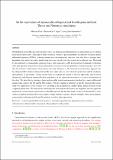| dc.contributor.author | Choi, Minseok | |
| dc.contributor.author | Sapsis, Themistoklis P. | |
| dc.contributor.author | Karniadakis, George Em | |
| dc.date.accessioned | 2016-08-08T19:43:06Z | |
| dc.date.available | 2016-08-08T19:43:06Z | |
| dc.date.issued | 2014-04 | |
| dc.date.submitted | 2014-03 | |
| dc.identifier.issn | 00219991 | |
| dc.identifier.uri | http://hdl.handle.net/1721.1/103865 | |
| dc.description.abstract | The Karhunen–Lòeve (KL) decomposition provides a low-dimensional representation for random fields as it is optimal in the mean square sense. Although for many stochastic systems of practical interest, described by stochastic partial differential equations (SPDEs), solutions possess this low-dimensional character, they also have a strongly time-dependent form and to this end a fixed-in-time basis may not describe the solution in an efficient way. Motivated by this limitation of standard KL expansion, Sapsis and Lermusiaux (2009) [26] developed the dynamically orthogonal (DO) field equations which allow for the simultaneous evolution of both the spatial basis where uncertainty ‘lives’ but also the stochastic characteristics of uncertainty. Recently, Cheng et al. (2013) [28] introduced an alternative approach, the bi-orthogonal (BO) method, which performs the exact same tasks, i.e. it evolves the spatial basis and the stochastic characteristics of uncertainty. In the current work we examine the relation of the two approaches and we prove theoretically and illustrate numerically their equivalence, in the sense that one method is an exact reformulation of the other. We show this by deriving a linear and invertible transformation matrix described by a matrix differential equation that connects the BO and the DO solutions. We also examine a pathology of the BO equations that occurs when two eigenvalues of the solution cross, resulting in an instantaneous, infinite-speed, internal rotation of the computed spatial basis. We demonstrate that despite the instantaneous duration of the singularity this has important implications on the numerical performance of the BO approach. On the other hand, it is observed that the BO is more stable in nonlinear problems involving a relatively large number of modes. Several examples, linear and nonlinear, are presented to illustrate the DO and BO methods as well as their equivalence. | en_US |
| dc.description.sponsorship | National Science Foundation (U.S.) (NSF/DMS (DMS-1216437)) | en_US |
| dc.description.sponsorship | Pacific Northwest National Laboratory (U.S.). Collaboratory on Mathematics for Mesoscopic Modeling of Materials (CM4) (DOE (DE-SC0009247)) | en_US |
| dc.description.sponsorship | United States. Dept. of Defense (OSD/MURI (FA9550-09-1-0613)) | en_US |
| dc.language.iso | en_US | |
| dc.publisher | Elsevier | en_US |
| dc.relation.isversionof | http://dx.doi.org/10.1016/j.jcp.2014.03.050 | en_US |
| dc.rights | Creative Commons Attribution-NonCommercial-NoDerivs License | en_US |
| dc.rights.uri | http://creativecommons.org/licenses/by-nc-nd/4.0/ | en_US |
| dc.source | Prof. Sapsis via Angie Locknar | en_US |
| dc.title | On the equivalence of dynamically orthogonal and bi-orthogonal methods: Theory and numerical simulations | en_US |
| dc.type | Article | en_US |
| dc.identifier.citation | Choi, Minseok, Themistoklis P. Sapsis, and George Em Karniadakis. "On the equivalence of dynamically orthogonal and bi-orthogonal methods: Theory and numerical simulations." Journal of Computational Physics 270 (August 2014), pp.1-20. | en_US |
| dc.contributor.department | Massachusetts Institute of Technology. Department of Mechanical Engineering | en_US |
| dc.contributor.mitauthor | Sapsis, Themistoklis P. | en_US |
| dc.relation.journal | Journal of Computational Physics | en_US |
| dc.eprint.version | Original manuscript | en_US |
| dc.type.uri | http://purl.org/eprint/type/JournalArticle | en_US |
| eprint.status | http://purl.org/eprint/status/NonPeerReviewed | en_US |
| dspace.orderedauthors | Choi, Minseok; Sapsis, Themistoklis P.; Karniadakis, George Em | en_US |
| dspace.embargo.terms | N | en_US |
| dc.identifier.orcid | https://orcid.org/0000-0003-0302-0691 | |
| mit.license | PUBLISHER_CC | en_US |
